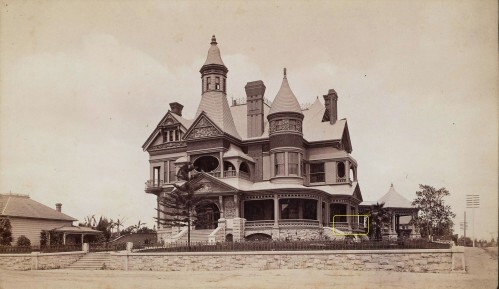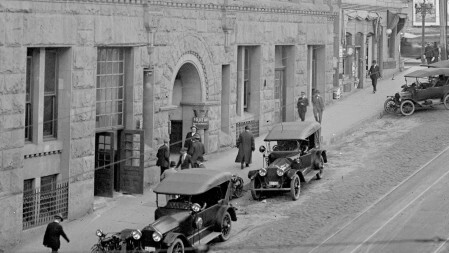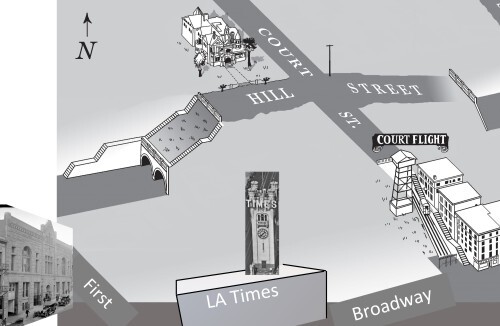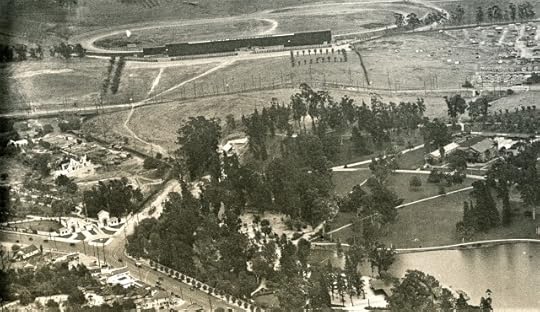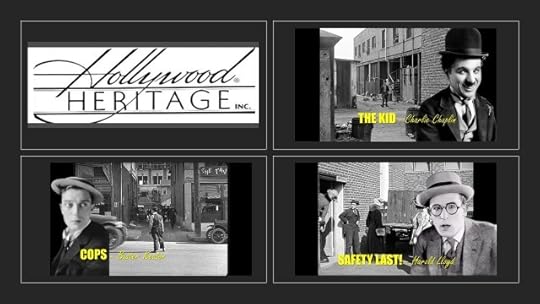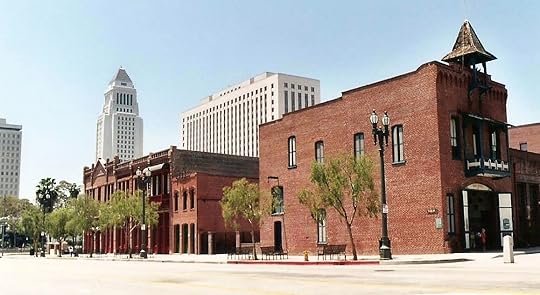John Bengtson's Blog, page 6
January 8, 2022
Take the Tour – the Buster Keaton Studio
I first read Rudi Blesh’s biography Keaton in junior high, and was immediately hooked by Buster’s magic and the romance of early filmmaking. I grew up watching silent comedies on public television, and collecting 8mm prints of Charlie Chaplin and Laurel & Hardy, fascinated by the world inhabited by the great silent-era comedians. Although they walked beside real buildings, and drove on public streets, their world seemed as alien and remote as if from another planet – silent, colorless, beyond reach.
I knew this world was once real, but the only tangible sense I had of it then was this image from Blesh’s book (left and above), of Buster and crew gazing proudly at the 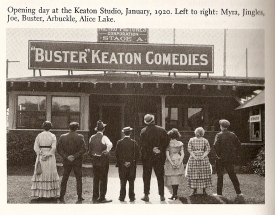 modest front office bungalow of his newly christened studio at the SW corner of Lillian Way and Eleanor. [Note: decades later we understand now Blesh miscaptioned the photo – the costumes confirm these are the cast members from Neighbors (1920), including Buster’s dad Joe standing left of Buster. That is not Myra, Buster’s mom, on the far left, that woman is too tall, and that’s cast member Big Joe Roberts, much taller than Roscoe Arbuckle, on Buster’s right].
modest front office bungalow of his newly christened studio at the SW corner of Lillian Way and Eleanor. [Note: decades later we understand now Blesh miscaptioned the photo – the costumes confirm these are the cast members from Neighbors (1920), including Buster’s dad Joe standing left of Buster. That is not Myra, Buster’s mom, on the far left, that woman is too tall, and that’s cast member Big Joe Roberts, much taller than Roscoe Arbuckle, on Buster’s right].

Click to enlarge – the studio in 1916, four years before Buster, in preparation for Charlie Chaplin to film his first Mutual comedy The Floorwalker.
The studio group photo was tantalizing. Buster walked up those simple front porch steps into his studio every day for eight years, but there was so little to see, so little explained. Without any context, the group photo was completely inaccessible. It seemed there was only so much we would ever know about how Buster made his movies.
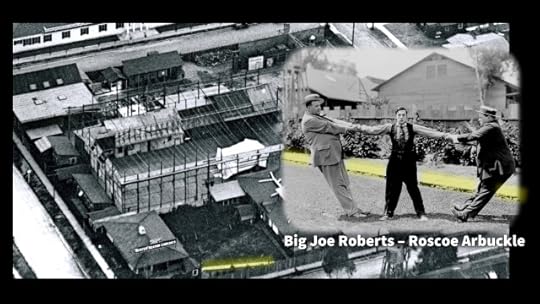 Keaton’s centenary in 1995 changed everything. His entire oeuvre of silent films were suddenly made available on home video, and the newly formed International Buster Keaton Society (the Damfinos) began their joyful campaign promoting Buster around the world. In 1996, the Damfinos published a glossy magazine, The Great Stone Face, including a 1921 aerial photo of the Keaton Studio (a portion of which appears above).
Keaton’s centenary in 1995 changed everything. His entire oeuvre of silent films were suddenly made available on home video, and the newly formed International Buster Keaton Society (the Damfinos) began their joyful campaign promoting Buster around the world. In 1996, the Damfinos published a glossy magazine, The Great Stone Face, including a 1921 aerial photo of the Keaton Studio (a portion of which appears above).
 Viewing that aerial photo for the first time was such a thrill, providing context missing from the Blesh photo, allowing us to “peek” over the studio fence for the first time. Incredibly, Buster’s lost world slowly re-emerged as I began to recognize certain bungalows and other landmarks from his films. I have since described dozens of scenes filmed at or beside Buster’s studio in my book Silent Echoes, and throughout posts on this blog.
Viewing that aerial photo for the first time was such a thrill, providing context missing from the Blesh photo, allowing us to “peek” over the studio fence for the first time. Incredibly, Buster’s lost world slowly re-emerged as I began to recognize certain bungalows and other landmarks from his films. I have since described dozens of scenes filmed at or beside Buster’s studio in my book Silent Echoes, and throughout posts on this blog.

Click to enlarge – from Steamboat Bill, Jr. (1928), possibly the final scene Buster filmed at his studio before moving to M-G-M.
But now, most gratifyingly, I have created a Silent Locations YouTube channel posting visual narratives showing (not telling) how silent-era Hollywood once looked a century ago. Please accept my invitation to take this visual tour of Buster’s studio, without spoken narration, accompanied only by silent film accompanist Frederick Hodges’ beautiful score.
So please – Take the Tour – and visit the Buster Keaton StudioDownload a fully annotated PDF walking tour of the Keaton Studio, with many more discoveries, click HERE.
Here too is a YouTube video of me leading this walking tour of the Keaton Studio site, filmed and hosted by my friend Ken Mitchroney – https://youtu.be/kr5mFWWXZjA
December 12, 2021
Lady Cops (and Harold Lloyd) Reveal 1914 Lost LA Treasures
What time machines! Thanks to the Eastman Museum, vivid details of downtown LA’s most iconic (and now sadly lost) landmarks fill the background of the 1914 gender reversal comedy Forcing the Force, restored and streaming on the museum site. Harold Lloyd’s 1917 Lonesome Luke Messenger comedy, streaming on the Lloyd site, discussed further below, adds more time travel views, and Charlie Chaplin and Stan Laurel will appear later as well.


Forcing the Force (re-released in 1917 as Hoodwinking the Police) depicts two young women, unemployed and desperate to pay the rent, joining the police force in response to a want-ad seeking only women recruits. They are sitting beside the side entrance stairs of the Bradbury Mansion porch, next to the section with a metal railing, marked below – click to enlarge.
Forcing the Force was released six years before women were allowed to vote, and as was common with mainstream entertainment at the time, depicts employment discrimination and sexual harassment as simply “normal” and comedic. Despite a few cringe-worthy moments, the movie is an incredible time machine, capturing daily life, and never-before-seen details of lost LA landmarks. For example, I have never before seen an image taken from the Bradbury Mansion porch. Huntington Digital Library.
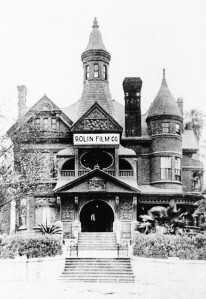 Our heroines read the want-ad sitting beside the incredible Bradbury mansion, built in 1887 atop Court Hill overlooking the LA Civic Center, at the time one of the city’s finest home. When the wealthy elite began moving west to more remote and exclusive neighborhoods, the mansion was used as one of the town’s initial movie studios. It was here Harold Lloyd and producer Hal Roach first joined forces in 1915 to create their earliest films under the Rolin Film Company banner. The pair, along with Lloyd co-stars Bebe Daniels and Snub Pollard, created more than one hundred films during their time working together at what Lloyd called “Pneumonia Hall,” including Lonesome Luke Messenger discussed further below. Lloyd and Roach filmed at the mansion until 1920, when Roach built new facilities out in Culver City, and changed the studio name to the Hal Roach Studios. The mansion was demolished in 1929, and for many years the hilltop site was used as a parking lot! Marc Wanamaker – Bison Archives.
Our heroines read the want-ad sitting beside the incredible Bradbury mansion, built in 1887 atop Court Hill overlooking the LA Civic Center, at the time one of the city’s finest home. When the wealthy elite began moving west to more remote and exclusive neighborhoods, the mansion was used as one of the town’s initial movie studios. It was here Harold Lloyd and producer Hal Roach first joined forces in 1915 to create their earliest films under the Rolin Film Company banner. The pair, along with Lloyd co-stars Bebe Daniels and Snub Pollard, created more than one hundred films during their time working together at what Lloyd called “Pneumonia Hall,” including Lonesome Luke Messenger discussed further below. Lloyd and Roach filmed at the mansion until 1920, when Roach built new facilities out in Culver City, and changed the studio name to the Hal Roach Studios. The mansion was demolished in 1929, and for many years the hilltop site was used as a parking lot! Marc Wanamaker – Bison Archives.


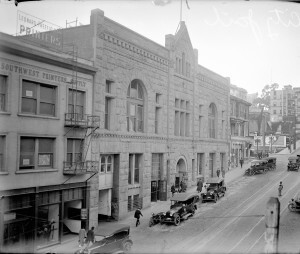 Click to enlarge – above, our job-seeking heroines stroll beside the decorative arched entrance way to the former Los Angeles City Jail once standing at First Street. The former Los Angeles County Jail stood a block east. You can actually read the “POLICE COURTS” sign appearing in the movie in this vintage photo. Few photos survive of this long lost jail facility, and again, this is first time I have ever seen such clear details of the jail entrance. UCLA, Library Special Collections.
Click to enlarge – above, our job-seeking heroines stroll beside the decorative arched entrance way to the former Los Angeles City Jail once standing at First Street. The former Los Angeles County Jail stood a block east. You can actually read the “POLICE COURTS” sign appearing in the movie in this vintage photo. Few photos survive of this long lost jail facility, and again, this is first time I have ever seen such clear details of the jail entrance. UCLA, Library Special Collections.


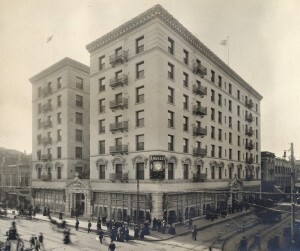 Click to enlarge – one new female member of the force arrives to relieve a harried traffic cop from his post at the busy intersection of 4th and Spring (notice the crowd of onlookers at back). Pictured here in 1906, the grand Angelus Hotel (now a parking lot) once stood at the SW corner of 4th and Spring. A bit of the hotel’s decorative entrance way appears to the far left of the right frame. California State Library.
Click to enlarge – one new female member of the force arrives to relieve a harried traffic cop from his post at the busy intersection of 4th and Spring (notice the crowd of onlookers at back). Pictured here in 1906, the grand Angelus Hotel (now a parking lot) once stood at the SW corner of 4th and Spring. A bit of the hotel’s decorative entrance way appears to the far left of the right frame. California State Library.
We return now to the Bradbury Mansion site, where many scenes from Forcing the Force were filmed at or beside this stately home.
Augmented for this post, this map by Piet Schreuders (click to enlarge) shows the Bradbury Mansion sitting high atop Court Hill. To the lower left on First Street stands the LA City Jail where the women got their jobs, just one block away from the mansion porch. Notice too the railing overlooking the twin-bore Hill Street Tunnel running under Court Hill (discussed later). Next, notice at front the crenelated clock tower of the former LA Times Building that once stood at the corner of First and Broadway, just a block away from the mansion. Last, although not featured in the movie, notice at the right the Court Flight incline railway that once transported people from Broadway up to the top of Court Hill. LA once had two incline railways – the other railway, Angels Flight, still stands near 3rd and Grand downtown.


A panoramic view of the Bradbury Mansion sidewalk entrance steps – left, in 1917 with Harold Lloyd in Lonesome Luke Messenger, and three years earlier, in 1914, as one of the heroines implores a fellow officer to help her in Forcing the Force. USC Digital Library.


Seen here with Bebe Daniels, Harold portrays “Lonesome Luke,” long before adopting his later trademark “Glasses” character. The women are sitting further back on the porch, between Bebe and Harold.


Harold also offers a closer view of the mansion entrance. (That’s really Harold rolling down those cement stairs).


Harold made dozens of movies at this mansion studio, nearly all are lost. But look, Charlie Chaplin filmed here too. Our heroine waters the lawn beside the mansion main entrance steps in 1914. A year later, Charlie played an overworked paperhanger when filming Work at the same mansion steps in 1915.
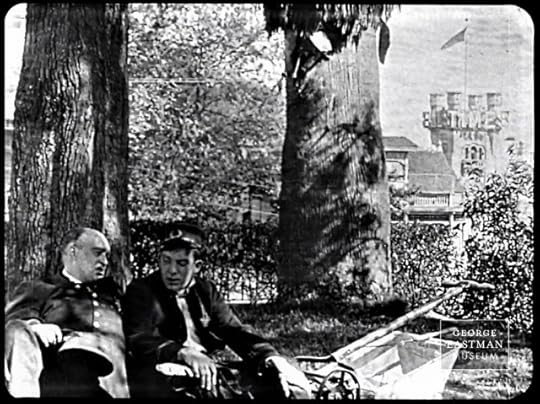

You are witnessing a unicorn. I’ve studied vintage LA photos for over 25 years, and I have never before seen a view from the mansion front lawn toward the LA Times tower at First and Broadway nearby. The tower is at eye level because the mansion stood on a hill – see the aerial view above. LAPL.
Let’s focus now on the rarely photographed railing overlooking the Hill Street Tunnel. This panorama was created with frames from the 1921 Monty Banks comedy Nearly Married (streaming Archive.org), and Harold’s Lonesome Luke Messenger. Remember, the enormous Bradbury Mansion is just off camera to the right.
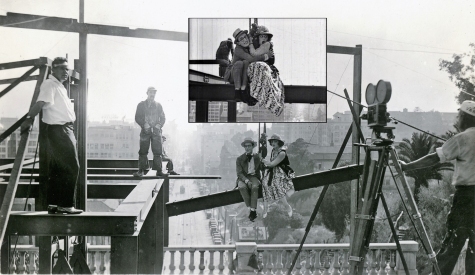 Click to enlarge – filming from the terrace looking south down Hill Street, while cropping the railing from view, created the illusion of great height. This still from Harold’s Look Out Below (1919) shows Hal Roach at the far left, with Snub Pollard, and Bebe Daniels.
Click to enlarge – filming from the terrace looking south down Hill Street, while cropping the railing from view, created the illusion of great height. This still from Harold’s Look Out Below (1919) shows Hal Roach at the far left, with Snub Pollard, and Bebe Daniels. 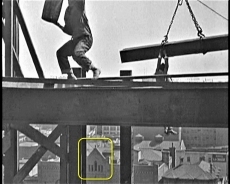 Harold would also film High and Dizzy (1919) and Never Weaken (1921) here, using elaborate sets to create the illusion he was climbing high in the air. The box in this inset view from Never Weaken marks the peaked facade of the LA City Jail, just a block away. Many more “thrill” comedies were filmed above the Hill Street Tunnel too. For variety, some other thrill comedies were filmed the same way, but instead with sets overlooking the Broadway (now lost) or Third Street Tunnels. This post explains the many downtown tunnels appearing in early comedies and film noir. Photo Marc Wanamaker – Bison Archives.
Harold would also film High and Dizzy (1919) and Never Weaken (1921) here, using elaborate sets to create the illusion he was climbing high in the air. The box in this inset view from Never Weaken marks the peaked facade of the LA City Jail, just a block away. Many more “thrill” comedies were filmed above the Hill Street Tunnel too. For variety, some other thrill comedies were filmed the same way, but instead with sets overlooking the Broadway (now lost) or Third Street Tunnels. This post explains the many downtown tunnels appearing in early comedies and film noir. Photo Marc Wanamaker – Bison Archives.


Forcing the Force makes more modest use of the Hill Street Tunnel railing, as a simple hiding place for the women and one cop to hide from the others running up the stairs beside the tunnel. That painted “HOTEL LA CROSSE” sign near the center of the right frame is a dead giveaway. If you watch enough silent comedies, you will see that sign appear over and over again, including during Charlie Chaplin’s Shoulder Arms (1918) and Buster Keaton’s Three Ages (1923).
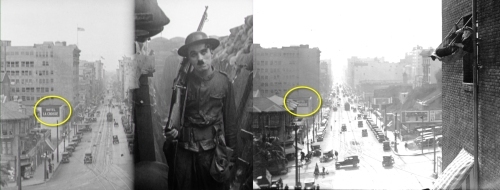
The Hotel La Crosse, viewed from the railing – Shoulder Arms, Three Ages


In closing, Forcing the Force has one more charming surprise. They built a small interior set on the sidewalk in front of the mansion, facing the railing overlooking the tunnel, so one of the women could peek through her window and react to a policeman approaching her home from the tunnel stairs. In the days preceding CGI and rear projection effects, the only way to present a real life backdrop from the window of a set was to build the set on site. For comparison, the matching right frame is the closing shot from Stan Laurel’s solo 1918 comedy Do You Love Your Wife?, with Stan being led the toward the mansion sidewalk entrance and further back the tunnel stairs.
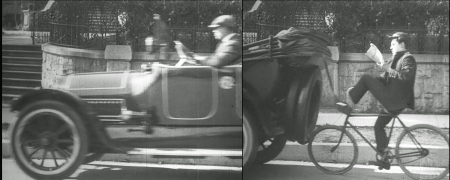
Hitching a ride, messenger Lonesome Luke arrives in style at the mansion
Forcing the Force, Lonesome Luke Messenger, Chaplin’s Work, and Do You Love Your Wife? each contain many more scenes filmed on Court Hill, showing bits of the mansion and neighboring sidewalks and homes, but it’s time to end this post. If you’ve ever wondered why Hill Street in downtown LA is flat, it’s because Court Hill, the hill that gave Hill Street its name, sadly no longer exists. In the name of progress, Court Hill and the surrounding neighborhood were bulldozed into oblivion. Except for street names, nothing appearing in this post remains today. Movies are time machines – moments of time captured frame by frame and frozen on film. Forcing the Force captures rare and vivid details of downtown LA life from over a century ago. We should all be so grateful to the Eastman Museum for preserving and streaming this evocative film.
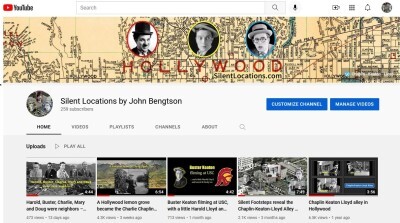 I hope you will check out my new YouTube channel.
I hope you will check out my new YouTube channel.
Below, what was once Court Hill, now only a memory captured on film.
November 28, 2021
Silent Locations YouTube Channel
After writing three books, and nearly 300 blog posts explaining the visual history hidden in silent movies, I’ve learned how to make YouTube videos that show this history directly. I’ve prepared over 15 Blu-ray/DVD bonus programs, and been invited to introduce films using PowerPoint over sixty times, so from this reservoir of material I plan to release YouTube videos regularly. Here’s the link to my new channel, and links to each video below.
Silent Locations YouTube Channel
The channel includes a Playlist of my video presentations hosted by museums and other groups.
Harold, Buster, Charlie, Mary and Doug were once neighbors – score by the Mont Alto Motion Picture OrchestraA Hollywood lemon grove became the Charlie Chaplin Studio – with Chaplin’s beautiful score from The KidA century ago, Buster Keaton filmed four movies at the then-small USC campus – a few Harold Lloyd and Laurel & Hardy locations tooSilent Footsteps – overlapping clues from a dozen silent films reveal the Chaplin-Keaton-Lloyd Alley – musical score by Jon MirsalisHonor the Chaplin-Keaton-Lloyd alley in HollywoodNovember 6, 2021
Ben Model presents Edward Everett Horton: 8 Silent Comedies
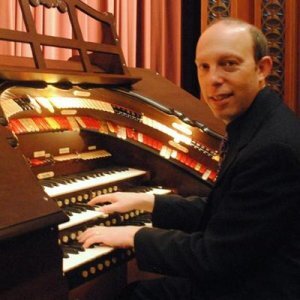 With now this third post, let me repeat, musician Ben Model is a silent film SUPER-HERO. Aside from his duties as resident accompanist for MoMA in New York, the Library of Congress, and performing at silent screenings around the country, his indie Undercrank Productions has released well over 20 rare silent movie DVDs. I only became aware of the delightful Alice Howell comedies (Alice Howell Collection) and the equally delightful Doug MacLean light comedies (The Douglas MacLean Collection) because Ben had first tirelessly assembled, restored, scored, and released these essential early films to home video. More remarkably, Ben and film author-historian Steve Massa host a weekly live-streamed silent film comedy show The Silent Comedy Watch Party Sunday afternoons at 3pm EDT on YouTube. (This post HERE
With now this third post, let me repeat, musician Ben Model is a silent film SUPER-HERO. Aside from his duties as resident accompanist for MoMA in New York, the Library of Congress, and performing at silent screenings around the country, his indie Undercrank Productions has released well over 20 rare silent movie DVDs. I only became aware of the delightful Alice Howell comedies (Alice Howell Collection) and the equally delightful Doug MacLean light comedies (The Douglas MacLean Collection) because Ben had first tirelessly assembled, restored, scored, and released these essential early films to home video. More remarkably, Ben and film author-historian Steve Massa host a weekly live-streamed silent film comedy show The Silent Comedy Watch Party Sunday afternoons at 3pm EDT on YouTube. (This post HERE 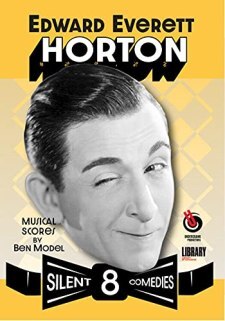 addresses a few early Hollywood scenes from Alice Howell’s films, while this post HERE highlights many overlaps between Doug MacLean and Harold Lloyd).
addresses a few early Hollywood scenes from Alice Howell’s films, while this post HERE highlights many overlaps between Doug MacLean and Harold Lloyd).
Ben’s latest production is an outstanding series of short silent comedies starring character actor Edward Everett Horton, as written, directed, and produced by various members of Harold Lloyd’s studio (Edward Everett Horton: 8 Silent Comedies). These long-forgotten films are funny, highly entertaining, and simply beautiful to watch. Given these films’ pedigree and high production values, it’s almost like watching a series of new Harold Lloyd shorts.



In the late 1920s audiences enjoyed Edward playing a series of fussy silent characters, unaware his voice would be perfectly suited to play similar roles in the talkie 1930s. Here, in No Publicity (1927), hoping to capture an exclusive news photo, photographer Edward crashes a socialite party, and ends up compelled to give the ladies an impromptu speech (while dressed in drag – it’s complicated). The society matron’s home (left), still standing, is located at 53 Fremont Place, one of the many magnificent homes built at this small gated community located south of Wilshire Boulevard, and also appears in The Red Kimono (1925) upper right (read all about The Red Kimono HERE).



At left, Edward hopes to crash the party by taking the ice-man’s place. These views from the matron’s home show 56 Fremont Place across the street (notice the “56” on the curb), the still-standing mansion where Mary Pickford once lived for a year in 1918, and that also appears in The Red Kimono (upper right) and as Jean Harlow’s home in Bombshell (1933) (lower right).



Edward’s elite equestrian, country club comedy Horse Shy (1928) includes a special effect shot of his runaway horse leaping over Beale’s Cut, a Santa Clarita landmark also appearing in Buster Keaton’s Seven Chance (1925), upper right. This 20 year old color view, lower right, shows how the gap has filled in over time.
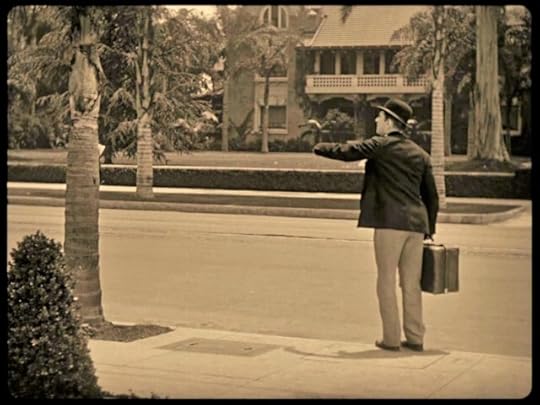


During Scrambled Weddings (1928) Edward flags down a taxi, with the grand home 3424 W. Adams Blvd. still standing in the background, although now partially blocked from view by a church. Photo Duncan Maginnis Historic Los Angeles.


In Scrambled Weddings Edward hopes to escape being forced to marry the wrong woman by sneaking between rooms at the grand, now lost, Brunswig mansion once located at 3528 W. Adams Blvd. Photo Duncan Maginnis Historic Los Angeles.



Later during Scrambled Weddings, Edward and his true love flee the front of the Brunswig Mansion, along the same steps appearing with Jimmy Cagney (upper right) in Blonde Crazy (1931). As reported HERE, the same mansion also appeared briefly in the Marx Bros. 1931 movie Monkey Business.
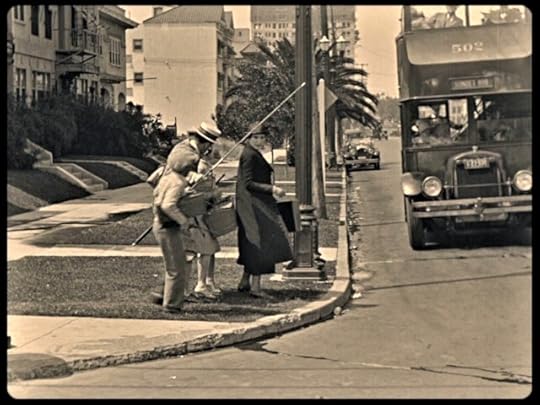

During Vacation Waves (1928), Edward’s dream of a relaxing vacation with his wife is dashed when his towering mother-in-law and pesky young brother-in-law tag along. Here they flag a bus looking south down Rampart Ave. from the corner of W 4th Street.


During Vacation Waves, a frustrated bus attendant orders Edward to take the upper deck. 417 N. Rampart appears behind him.


Vacation Waves features many lengthy tracking shots traveling north up N. Rampart, pictured here with the cross street of W 6th in the background.
 If the Vacation Waves double decker bus scenes along Rampart (the street running the full width of the photo above) look familiar, Harold Lloyd filmed double decker bus scenes from For Heaven’s Sake (1926) there as well, perhaps inspiring his crew to return there for Edward’s film.
If the Vacation Waves double decker bus scenes along Rampart (the street running the full width of the photo above) look familiar, Harold Lloyd filmed double decker bus scenes from For Heaven’s Sake (1926) there as well, perhaps inspiring his crew to return there for Edward’s film.


Edward’s bus travels all the way north up Rampart and turns right onto Beverly Blvd.

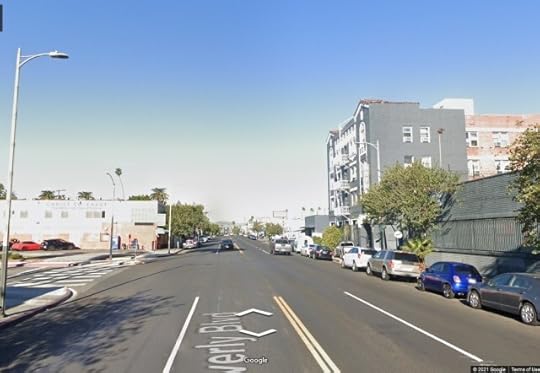
Completing the turn provides a rare view west down Beverly. That apartment at back is still standing.

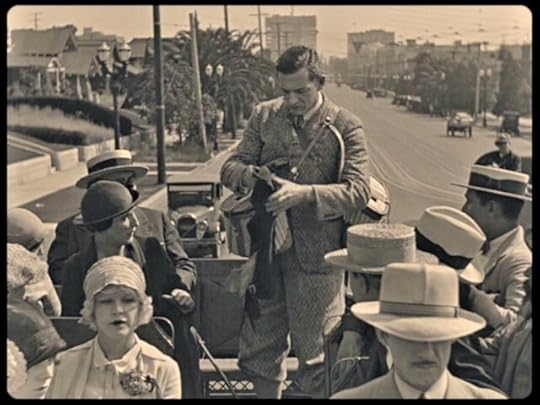
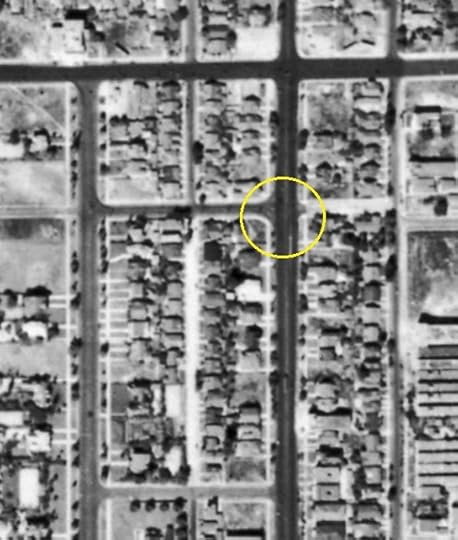
Looking north (upper left) and south (lower left), the film captures where the trolley line once turned left, west, onto W 2nd Street (oval).


The family begin their fishing vacation at Newport Beach. While Harold Lloyd does not appear to have ever filmed here, Buster Keaton filmed five silent movies here (some later talkies too), including this start of the boat racing scene from College (1927). Notice the matching homes on Balboa Island at back. The water tower in College places this directly across from the Newport Beach Pavilion.
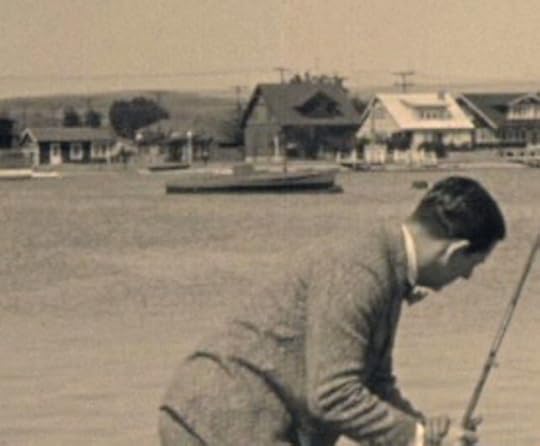

While most homes have been heavily remodeled, the white house above Edward’s head and the home to left, 258 and 256 S Bay Front, both remain relatively unchanged.

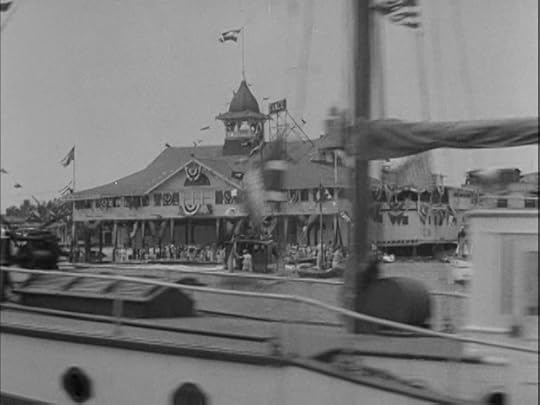

A parting shot from Vacation Waves (left). Built in 1905, the Newport Beach Pavilion (as seen in Buster Keaton’s The Cameraman (1928) upper right) has been a landmark for more than a hundred years. At the time tourists could travel to the pavilion from downtown Los Angeles in about an hour by taking the Pacific Electric Red Car.
 Two other films from the set, Call Again (1928) and Dad’s Choice (1928) feature many street level views along Hollywood Blvd, especially near Highland, and both at, and along, Sycamore. Extensive scenes from Dad’s Choice were also filmed at what is now the William Andrews Clark Memorial Library. Click to enlarge, and you can read the its 2205 W. Adams address sign in this frame.
Two other films from the set, Call Again (1928) and Dad’s Choice (1928) feature many street level views along Hollywood Blvd, especially near Highland, and both at, and along, Sycamore. Extensive scenes from Dad’s Choice were also filmed at what is now the William Andrews Clark Memorial Library. Click to enlarge, and you can read the its 2205 W. Adams address sign in this frame.
In closing, we should all be so grateful to Ben, and for all the silent movie entertainment and history he has reclaimed for us. We also owe an immense debt of gratitude to Richard Simonton Jr. for rescuing these prints from Harold Lloyd’s film vault, and placing them in the Library of Congress. The Edward Everett Horton: 8 Silent Comedies DVD set is simply fantastic, so much fun, so clever, so beautifully filmed. Unavailable for nearly a century, thanks to Ben and Richard, we can now enjoy these eight “new” entertaining comedies we might not otherwise have ever been able to see.
Below, the corner of 4th and Rampart where Edward’s family boards the bus in Vacation Waves.
October 23, 2021
The Roaring Road – rare ‘new’ views of early Hollywood

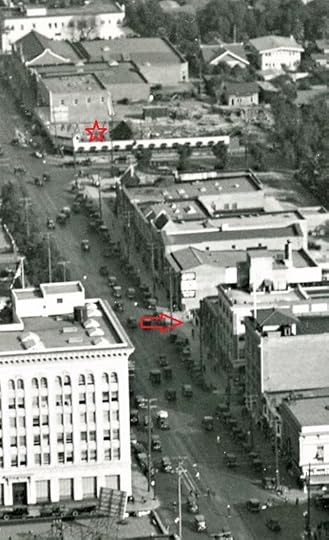 Above, a rare time capsule glimpse looking east from Cahuenga toward the towering Taft Building at the SE corner of Hollywood and Vine, before the neighboring Broadway (B. H. Dyas) Building was built on the SW corner in 1928. The image comes from The Roaring Road (1926), an auto-racing comedy-adventure recently premiered on TCM, found and restored by Mark Heller’s Streamline Cinema and funded by The Academy Film Archive, with a score composed and performed by Jon C. Mirsalis. At right, a matching 1923 aerial view looking east – the star marks the Taft Building construction site, already underway. The arrow marks the once uninterrupted stretch of Hollywood Blvd. before Ivar Street was extended north to the boulevard, creating a new corner not evident in these images. While at one level The Roaring Road is a only a modest production, it also provides many sparkling and unique views of Hollywood during the height of the mid-1920s construction boom. So buckle up for another tour of early Hollywood as captured in the background of silent film. HollywoodPhotographs.com
Above, a rare time capsule glimpse looking east from Cahuenga toward the towering Taft Building at the SE corner of Hollywood and Vine, before the neighboring Broadway (B. H. Dyas) Building was built on the SW corner in 1928. The image comes from The Roaring Road (1926), an auto-racing comedy-adventure recently premiered on TCM, found and restored by Mark Heller’s Streamline Cinema and funded by The Academy Film Archive, with a score composed and performed by Jon C. Mirsalis. At right, a matching 1923 aerial view looking east – the star marks the Taft Building construction site, already underway. The arrow marks the once uninterrupted stretch of Hollywood Blvd. before Ivar Street was extended north to the boulevard, creating a new corner not evident in these images. While at one level The Roaring Road is a only a modest production, it also provides many sparkling and unique views of Hollywood during the height of the mid-1920s construction boom. So buckle up for another tour of early Hollywood as captured in the background of silent film. HollywoodPhotographs.com


The Roaring Road involves failing and feuding business partners who manufacture automobile engines. Their only hope to stay afloat is to design a new auto engine and win an upcoming speed race. This view east towards Hollywood and Vine shows one partner arriving at their office, and a matching view nearly a century later.

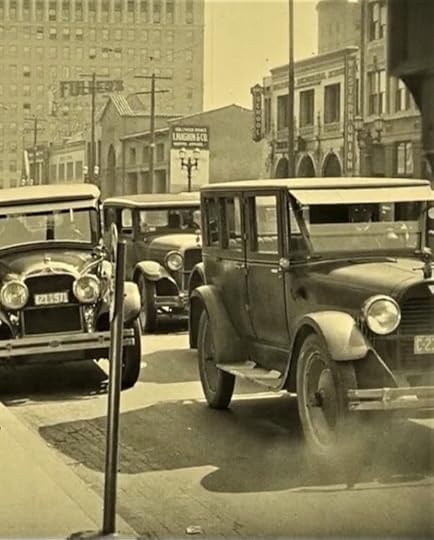
By 1934, above left, Ivar Ave. had been extended north connecting to Hollywood Blvd., placing the I. Magnin store on a corner lot that did not exist in 1926! You can see “I. Magnin” painted on the side of the store in the 1926 movie frame.
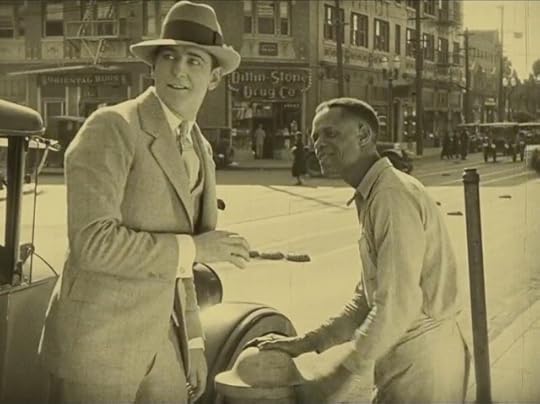

With a carefully tended fake fire hydrant, lead star Kenneth McDonald is always assured of a place to park when he arrives at the office. The Dillin & Stone Drug Co., at the SW corner of Western and 6th, appears at back. Interestingly, this view presented as looking west from the office is nearly 4 miles south from the earlier shot above along Hollywood Blvd. presented as looking east from the same office building.
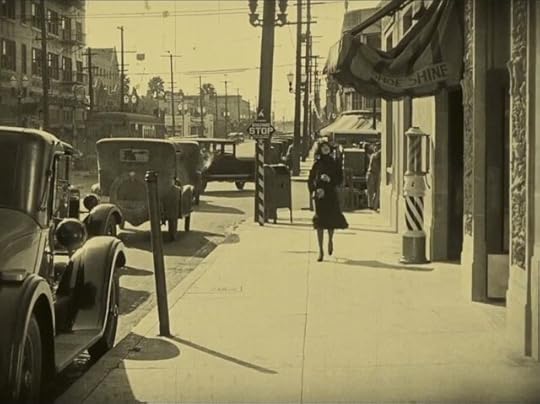

Kenneth portrays a skilled race-car driver, and the son of one business partner. Actress Jane Thomas portrays the daughter of the other business partner, shown above arriving at the 3923 W. 6th Street business office entrance to the right, flanked by beautifully detailed molding. Similar molding survives on the building’s upper floors, but sadly the ground level entrance details have been scrubbed clean. The yellow box in the modern view above marks the back of the Versailles Apartments also visible in the movie frame. The red box in the modern view marks a small alley entrance appearing in Harold Lloyd’s Safety Last! (1923) below.


Late for work in Safety Last!, Harold pretends to be injured to sneak a quick ride in a handy ambulance. When they reach the right spot, Harold politely requests the driver to stop, then leaps out the back dashing to work. This was staged at 6th Ave. looking east towards the corner of Western. (The very next shot in this Safety Last! sequence shows Harold running into the Chaplin-Keaton-Lloyd Alley).



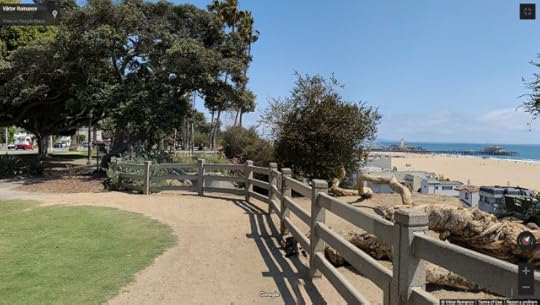
Is there any doubt they will find true love by the film’s end? Kenneth and Jane meet to discuss their feuding fathers along the rustic-fenced bluff at Palisades Park, looking south toward the Santa Monica Pier at back. The Palisades appears briefly in Chaplin’s By The Sea (1915), Lloyd’s A Sailor Made Man (1921), and Keaton’s The Love Nest (1923). While the Palisades overlooking the ocean will always be a beautiful setting, I can only imagine how romantic it must have been to stand there a century earlier, when no one had smart phones, and everything then was so unspoiled and undeveloped.
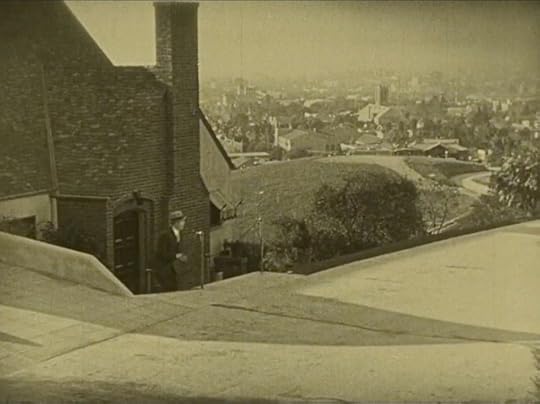

Kenneth and Jane end up designing their own car and automobile engine, and entering it in the speed race, with hopes of winning the grand prize and saving their fathers’ business. My eyes lit up when Kenneth dashes out of his home the day of the race. That familiar looking church at back is the First Presbyterian Church of Hollywood at 1760 N. Gower and Carlos. LAPL.
These thugs posing along Allview Terrace (more below) will soon kidnap Kenneth to keep him from competing in the race.

Kenneth checks his flat tire, courtesy of the thugs, affording a magnificent SW view towards buildings along Hollywood Blvd. – see captions next photo. The Knickerbocker Hotel C extends so far east it nearly blocks from view the Guaranty Building D behind it.

1925 view north: A – the Taft Building at Hollywood and Vine, B – the Plaza Hotel on Vine, C – the Knickerbocker Hotel, D – the Guaranty Building (nearly blocked in the movie view), and E – the Security Trust and Savings Bank at Hollywood and Cahuenga – HollywoodPhotographs.com

This earlier 1924 view looking NE shows the Allview Terrace filming site (box) and the same four buildings except for the Hollywood Plaza Hotel (B) not yet built. The box site also shows the public stairway, still in place, running from Hollyridge Dr. to Allview – HollywoodPhotographs.com

But there’s more – 1 is the Holly Vista Apartments still standing at 1975 N Beachwood, 2 is the towering Hollywood Storage Building still standing at 1035 N. Highland, and 3 is the large gas holding tank once standing at Formosa and Santa Monica Blvd., next to the Pickford-Fairbanks Studio.
And look! Essentially unchanged, Kenneth’s home remains standing at 2350 Allview Terrace, although trees and decades of other landscaping now all but block the wide panoramic views looking down on Hollywood.

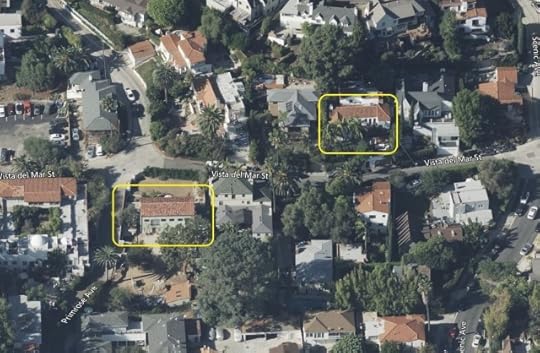

Above, two homes near the SW corner of Gower and Scenic (red), as well as homes along Vista Del Mar Street (yellow), remain following their appearance with the thugs.


The film concludes with a thrilling auto race, staged both at the Legion Ascot Speedway within Lincoln Heights below, but also cross-country along freshly cut hillside dirt roads likely filmed around Griffith Park and Mulholland Drive.

Legion Ascot Speedway 1924 view west. Click to expand, deep at back are the unshaded wooden bleachers. The site not only had an oval track, but adjoining open dirt roads also used for racing – Huntington Digital Library

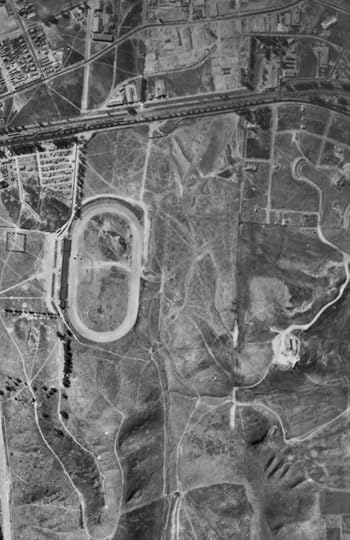
I will leave this to early racing experts, but I sense certain racetrack scenes showing large shaded bleachers were stock footage filmed somewhere else, as the Ascot images I’ve located all present more modest, nonshaded wooden bleachers. LAPL and FrameFinder c-113_357.
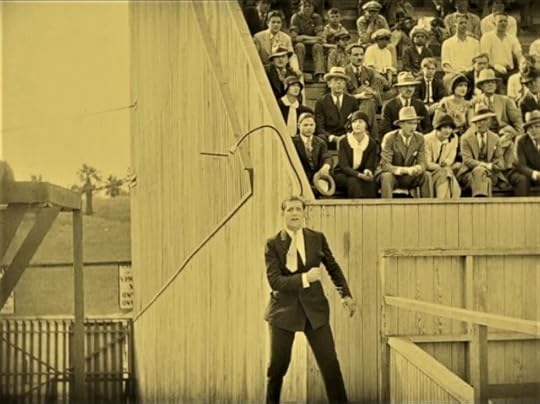

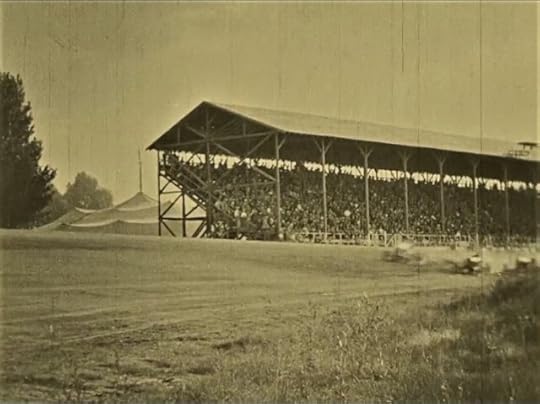
Freed from his kidnappers, this view looking west shows Kenneth beside the south end of the unshaded Ascot wooden bleachers, upper right, while these large shaded bleachers appearing in the film, lower right, must be stock footage of another race track. Notice the palm trees behind Kenneth and behind the upper right bleachers.
This view looks east across the back end of Lincoln Park, with the entrance to the Selig Zoo at the far left, and the back of the Ascot wooden bleachers at the top. The palm trees near the right end of the bleachers appear behind Kenneth above. HollywoodPhotographs.com

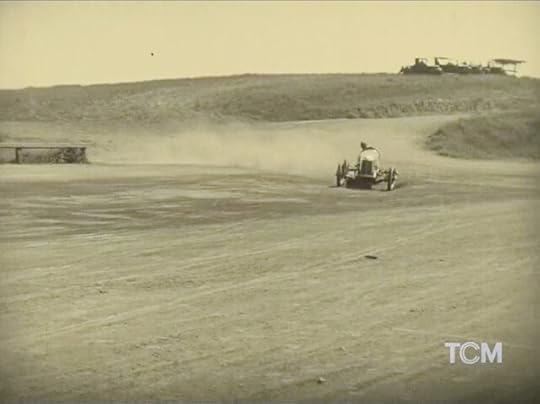

Notwithstanding the kidnapping and other challenges, Kenneth wins the race and the girl, while reuniting the feuding fathers, who have always secretly respected each other. Kenneth’s winning engine design? Blending one father’s preferred “force feed system” with the other father’s preferred “oversized exhaust ports” into a prize-winning hybrid engine that saves the business. D’oh! What a great idea – why didn’t I think of that?
Below, a closing view of Kenneth’s home.
df
October 9, 2021
Silent Movie Day celebrates the Chaplin-Keaton-Lloyd Alley
On September 29, 2021, the inaugural National Silent Movie Day, Hollywood Heritage celebrated the Chaplin-Keaton-Lloyd Alley with this beautiful plaque.
This story by the Hollywood Partnership provides a good overview of that special day. https://hollywoodpartnership.com/post/first-ever-national-silent-movie-day-comes-to-hollywood
It was crowded by the entrance – photo above Esotouric.

Left to right, Jackie Coogan’s grandson Keith Coogan, me – John Bengtson, Hollywood Heritage President Brian Curran, Councilmember Mitch O’Farrell, Harold Lloyd’s grand-daughter Suzanne Lloyd, Cinecon President Stan Taffel, Charlie Chaplin’s grand-daughter Kiera Chaplin, Buster Keaton’s great-grand-daughter Keaton Talmadge, Chaplin’s life-long cameraman Rollie Totheroh’s grand-son David Totheroh. Photo Harrison Engle.
A century later, five living descendants of Charlie, Buster, Harold, Jackie Coogan, and Rollie Totheroh meet for the first time, where their ancestors (little Jackie excepted) all once spent days filming.

The sign and plaque unveiled – photo Harrison Engle
This post HERE on the National Silent Movie Day site also explains the day. More than a dozen volunteers from Hollywood Heritage and the EaCa Alley Property Owners worked hours and hours to make this special day happen, for which I will always be grateful.
Step by silent footstep, clues from a dozen silent films collectively reveal a century-old secret, the humble Chaplin-Keaton-Lloyd Alley where three timeless comedies were made.
Here below is the text of my brief speech at the ceremony, explaining the nine-way improbability this alley exists:
Hi everyone – Happy National Silent Movie Day! I’m John Bengtson, thank you so much for coming.
Imagine yourself standing here in 1914 when the movies in Hollywood began. The modest corner of Cahuenga and Hollywood Blvd. was an early town center. Hollywood was so undeveloped then that south of where we’re standing was just empty fields and vacant lots. Charlie Chaplin built his studio in the middle of a lemon grove, and kept dozens of trees on his lot after it opened in 1918.
This block, the 1600 block of Cahuenga, was the center of early silent filming. I’ve identified 50 silent movies filmed here, more so than for any other Hollywood street. And this block was also the favorite Hollywood street with Chaplin, Keaton, and Lloyd. Charlie filmed four movies here, Harold filmed five, and Buster filmed here eight times.
Why here? Well the Famous Players Lasky Studio, the original site of the Hollywood Heritage Barn, stood two blocks away at Selma and Vine, and Universal City was just a mile or two north. So this was the easiest place to shoot a handy street corner. As a bonus, our alley stood nearby. I’ve identified two dozen movies filmed at the alley, many from Universal, and it was exciting to see early Universal directors like Lois Weber, Cleo Madison, and Grace Cunnard had filmed here too. Given how so many silent films are lost, it’s easy to imagine many more movies were filmed at the alley as well.
Just here at this entrance to the alley flapper superstar Colleen Moore snuck past during Her Bridal Nightmare, the King of Hollywood Douglas Fairbanks ran in fleeing for his life in Flirting With Fate, Oliver Hardy, without his moustache, and before being paired with Stan Laurel, chased Billy West out of this entrance during Rivals, and the Handcuff King, escape artist Harry Houdini, dramatically fled from this entrance during The Grim Game.
Which brings us to our special guests. Charlie Chaplin, Buster Keaton, and Harold Lloyd, the three kings of silent comedy each filmed a masterpiece at this alley; The Kid, Cops, and Safety Last!; each inducted into the National Film Registry of the Library of Congress, cinema’s highest honor. This six-way constellation of iconic stars and timeless films is absolutely unique in Hollywood history. I’ve struggled how to convey how staggeringly unlikely it is for this place to exist. It’s like hitting a hole-in-one, but more precisely, hitting a hole-in-one six times in a row.
But it’s more remarkable than that. First, after 100 years this alley still exists. The favorite places for Charlie, Buster, and Harold to shoot, like Bunker Hill, the old Chinatown, and Ducommun Street downtown, no longer exist. They are buried under freeways or redeveloped into oblivion. So our little alley surviving more than a century counts as hole-in-one number seven.
Next, overlapping clues from a dozen silent films allowed this mystery to be solved. The key was a little-known newspaper drama from 1925 called The Last Edition. Most movies filmed here only looking in one direction or another. But The Last Edition filmed in eight different directions – it was the Rosetta Stone tying all the other movies together. The movie languished in an archive unseen for 90 years until the San Francisco Silent Film Festival restored and screened this entertaining film. If The Last Edition had not been revived, solving this mystery, we wouldn’t be here today. So that counts as hole-in-one number eight.
Last, I want to thank Hollywood Heritage, led by President Brian Curran, and the EaCa Alley Property owners, especially David Gajda and Aziz Banayan for hosting this event. More than a dozen people have each worked hours and hours to make today happen. Hollywood Heritage is such an important charity, they are all volunteers, and they work so hard to protect and preserve Hollywood landmarks and history. So, in these crazy, stressful times, when everyone is already so busy, Hollywood Heritage and the EaCa Alley owners somehow got together and decided to make today happen, and they did. So I want to thank them all again, and recognize today’s happy ceremony as our incredible hole-in-one number nine.
Don’t worry, we’re not going to play a full round of golf. Before I finish, I also want to thank Councilmember Mitch O’Farrell and his office staff for their support.
In closing, think back a hundred years, and put yourself in their place. Can you imagine? In one way or another, Chaplin, Keaton, and Lloyd each spent days filming here. They knew this alley; it was significant to them, they woke up mornings and drove here to work, and made landmark films here that became milestones in their careers. I have no doubt in later years they kept the memory of this place with them for as long as they lived. And now we can share these memories with them too. So with that, thank you once again to everyone for making this special day happen.
Here’s to the next hole-in-one! Thank you.
August 29, 2021
Step by silent footstep – how the Chaplin-Keaton-Lloyd Alley was revealed
Step by silent footstep, this visual narrative shows how clues from a dozen silent movies collectively revealed a century-old secret, the humble Chaplin-Keaton-Lloyd Alley where three timeless comedies were made. Limited text here and on the video, the visuals speak for themselves.
Please consider supporting Hollywood Heritage’s https://gofund.me/e712eed1 GoFundMe campaign to celebrate the alley and to install signs, a plaque, and even an honorary mural.
August 14, 2021
Hollywood Heritage Celebrates the Chaplin-Keaton-Lloyd Alley
Hollywood and “the movies” have been synonymous for over 100 years. Handprints in cement and the Walk of Fame honor stars from the past. But only now, with the exciting Hollywood Heritage campaign, will Hollywood celebrate its direct geographic connections to the film industry’s origins.
For convenience, and with scarce other choices, early filmmakers often staged scenes near the modest crossroads of Hollywood and Cahuenga, once the small town’s economic center. Standing close to where several studios would later be built, the Hollywood-Cahuenga junction became increasingly well-known among filmmakers, and as the town and industry grew, would become perhaps the busiest early filming site in all of Hollywood, appearing in dozens of silent films. For example, Charlie Chaplin, Buster Keaton, and Harold Lloyd each staged more scenes near this Hollywood intersection than at any other spot in town; Buster alone filmed eight different movies nearby.

1919 view west – Hollywood Blvd. at far right, alley highlighted. Even as late as 1919 most of Cahuenga was vacant. HollywoodPhotographs.com
As a bonus, and also well-known among the early filmmakers, an adjoining alley (highlighted above) running east-west from Cahuenga to Cosmo just south of Hollywood Blvd. provided an urban setting, sparing film crews a trip downtown to shoot. So, when the Kings of Silent Comedy needed a quiet alley location, they each knew where to go, resulting in their comic masterpieces The Kid, Cops, and Safety Last!
With each movie inducted into the National Film Registry of the Library of Congress as a “work of enduring importance to American culture,” cinema’s highest honor, the alley represents a six-way constellation of iconic stars and timeless films absolutely unique, both in Hollywood history, and throughout cinema itself.
Hollywood Heritage plans to celebrate the alley on September 29, 2021, the inaugural National Silent Movie Day, and has launched a GoFundMe campaign to install signs, a plaque, and even an honorary mural. Celebrating this site as the “Chaplin-Keaton-Lloyd Alley” will honor the legacy of these great filmmakers and, for the first time, directly celebrate Hollywood’s unique cultural, economic, and geographic heritage, all at the very spot that helped to grow an industry and inspire these films.
Think of it. They each spent days filming here. Chaplin filmed many scenes here for The Kid, with several different actors, perhaps shooting multiple takes each as was his practice. Keaton orchestrated an elaborate stunt here for Cops, managing a squad of police extras, while also filming many scenes here for Neighbors and My Wife’s Relations. And Lloyd filmed over two dozen scenes here for Safety Last!, as well as the closing scene for Never Weaken. 1920 view above HollywoodPhotographs.com.
There is no place in the entire country better suited to celebrate National Silent Movie Day than here, where so much movie magic was made.
Three Iconic Stars – Three Timeless Films – One Hollywood Alley
Cheers to Hollywood Heritage – a California nonprofit public benefit 501(c)(3) corporation, and its GoFundMe campaign to celebrate the Chaplin-Keaton-Lloyd Alley – https://gofund.me/ccda4942. If you want to honor a favorite star, or to recognize Hollywood’s origins and hidden history, please consider making a tax-deductible donation, and please share this campaign.
For tours and more information about the alley, read Chaplin-Keaton-Lloyd Alley.
July 30, 2021
Solved! Buster Keaton’s Mystery Colegrove Building


Buster Keaton was a pragmatic filmmaker, and it’s been fun discovering how often he would shoot simple scenes nearby, or even across the street from his small Hollywood studio once standing at 1025 Lillian Way. Appearing as both a receiving hospital that tosses him out the front door in The Goat (1921) (above left), and then as a justice of the peace office where Buster confuses potential brides in The Play House (1921), this unique recessed entrance-way and partial staircase had puzzled me for years. Knowing Buster’s working habits, I had long wondered if this curious doorway was the side entrance to some random Metro Studio building adjacent to Keaton’s studio. I scrutinized every Metro Studio photo I could find, but the doorway just never showed up.

Looking NW – Metro Studio at left, Keaton at right – no sign of matching doorway – HollywoodPhotographs.com
But as often happens, the answer to one silent film mystery was found within another.
During this scene above from the 1919 Billie Rhodes comedy A Two-Cylinder Courtship, a top-hat-wearing fake preacher (hired by Dad to halt the marriage) leads an eloping couple upstairs beside The Colegrove Restaurant once standing at 1105 N. Vine Street, one block north and east from the Keaton Studio. Colegrove was once a tiny agricultural community centered around Santa Monica Blvd. and Gower, south of Hollywood, itself once a tiny agricultural community. The Colegrove Lemon Exchange (later Cahuenga Valley Lemon Exchange), stood directly north of Keaton’s studio, and glimpses of it appear during The Scarecrow and The Goat.



The identical two-inch high step spanning the threshold, matching stairway post, and even matching doormat from The Goat (left), A Two-Cylinder Courtship, and The Play House, confirm these are all the same stairs leading to Henrietta Covarrubias’ upper floor boarding house at 1103 Vine Street. Further, Colegrove had very few other candidate buildings at the time, and this setting stood just a block from Buster’s studio. But is there more direct proof?

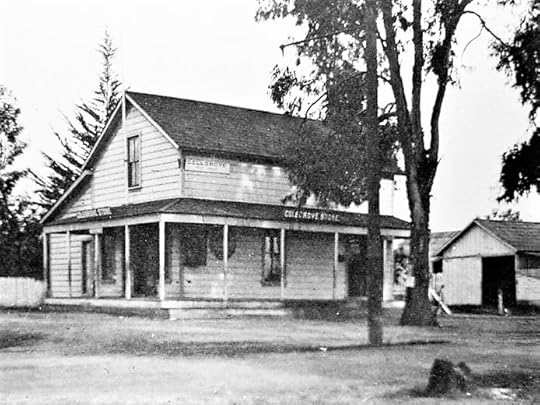
Well, after locking the couple in his room, the fake preacher then welcomes Dad and explains how he foiled the sneaky couple’s elopement. This scene was filmed looking east from the NW corner of Santa Monica and Vine towards the original Colegrove Post Office still standing at the time across the street. USC Digital Library.
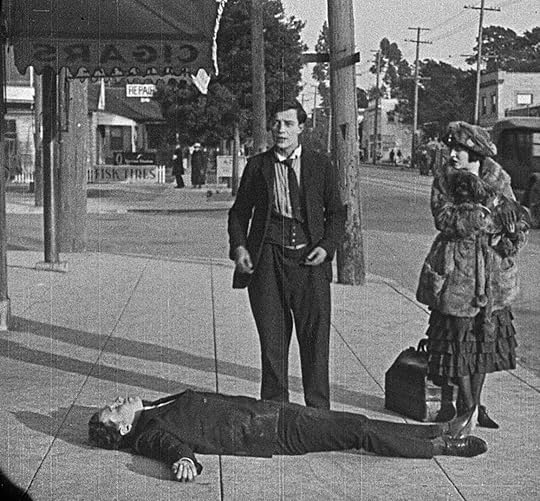

Next, already confirmed HERE as the NW corner of Santa Monica and Vine, look at this detail from The Goat, after Buster has vanquished a bully harassing Virginia Fox. At back stands a corner steel post supporting the upper floor. This same corner steel post also appears during A Two-Cylinder Courtship.


Finally, this brief shot of Buster’s horse from Cops (left) reveals Stafford Melanthial’s billiard parlor at 6303 Santa Monica Blvd., just west from the corner of Vine, showing the very same “Pocket Billiards” signs appearing in A Two-Cylinder Courtship. Clearly these various scenes were all filmed along the east and south sides of the same two-story building once standing at the NW corner of Santa Monica and Vine.
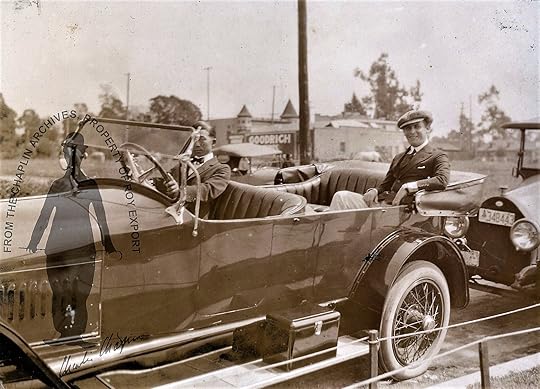
Looking NE at Lew Cody posed in front of the Chaplin Mutual Studio, later to become the Keaton Studio, looking towards the two towers of the Colegrove Mystery Building at back, the taller tower at the corner of Santa Monica and Vine, blocked from view by Marshall’s Garage (Goodrich Tires) – Charlie Chaplin Archives


The NW corner of Santa Monica and Vine stood one block north and east from the Keaton Studio on Eleanor. The smaller west tower of the Colegrove Mystery Building appears at left in this production photo from Keaton’s The Scarecrow (1920), blocked by Marshall’s Garage, the red garage building on the map. Buster built this set on what was then a vacant lot kitty-corner from his studio.
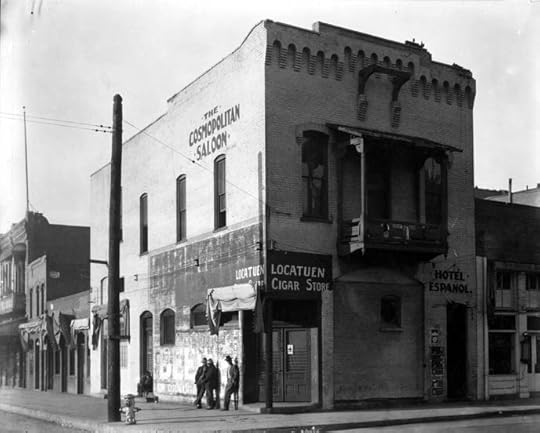


In closing, A Two-Cylinder Courtship was included as a bonus film to the evocative comedy-drama Dinty (1920), released on Blu-ray by Grapevine Video, depicting a spunky newsboy struggling to care for his ailing mother played by Colleen Moore. Dinty portrays dozens of fascinating scenes filmed near the Plaza de Los Angeles downtown, depicting small byways and alleys rarely documented in archival photos. I hope to post about Dinty’s amazing Plaza history someday. Above, a 1920 view of the Plaza Firehouse built in 1884 facing the Plaza (then the Cosmopolitan Saloon) and still standing, with matching views, upper right, from Dinty, and lower right, from the 1916 Dorothy Gish immigrant drama Gretchen the Greenhorn.
Above, the Plaza Firehouse today (the station appears during another scene from The Goat, read more HERE), and below, a gas station fills the NW Santa Monica and Vine corner site today.
July 13, 2021
The Kid – Chaplin’s Silent Footsteps tour now on YouTube
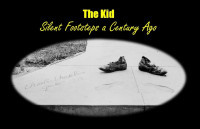 The 2021 Chaplin Days online festival hosted by the Niles Essanay Silent Film Museum includes my all-new video tour of Charlie’s century-old masterpiece The Kid (1921), revealing locations and the incredible visual history hidden in the background of the film. Now posted on YouTube, the show reveals Muhammad Ali would later own the mansion appearing early in the film.
The 2021 Chaplin Days online festival hosted by the Niles Essanay Silent Film Museum includes my all-new video tour of Charlie’s century-old masterpiece The Kid (1921), revealing locations and the incredible visual history hidden in the background of the film. Now posted on YouTube, the show reveals Muhammad Ali would later own the mansion appearing early in the film.
 Above, a frame grab from a once-lost film Derby Day (1922), available for DVD purchase thanks to Ben Model’s Undercrank Productions Found at Mostly Lost Vol. 2, provides a wide view of the site where Charlie filmed the rooftop chase and leap into the getaway orphanage truck. Charlie stands on the home directly behind the narrow triangle building.
Above, a frame grab from a once-lost film Derby Day (1922), available for DVD purchase thanks to Ben Model’s Undercrank Productions Found at Mostly Lost Vol. 2, provides a wide view of the site where Charlie filmed the rooftop chase and leap into the getaway orphanage truck. Charlie stands on the home directly behind the narrow triangle building.
 Above, an early view of the Plaza de Los Angeles and Chinatown highlighted with places where Chaplin filmed. Echoing his own impoverished London childhood, it’s stunning to see how often Charlie filmed in LA’s poorest parts of town.
Above, an early view of the Plaza de Los Angeles and Chinatown highlighted with places where Chaplin filmed. Echoing his own impoverished London childhood, it’s stunning to see how often Charlie filmed in LA’s poorest parts of town.
I had fun putting this together, and hope you will check it out, along with the many other 2021 Chaplin Days special programs and talks now hosted on the Niles Essanay Silent Film Museum YouTube Channel.
Above, my YouTube talk from last year’s Chaplin Days fully covers the many Bay Area locations where Charlie made his five Niles Essanay Studio movies in 1915.
The Kid and all images from Chaplin films made after 1918 Copyright © Roy Export S.A.S.

